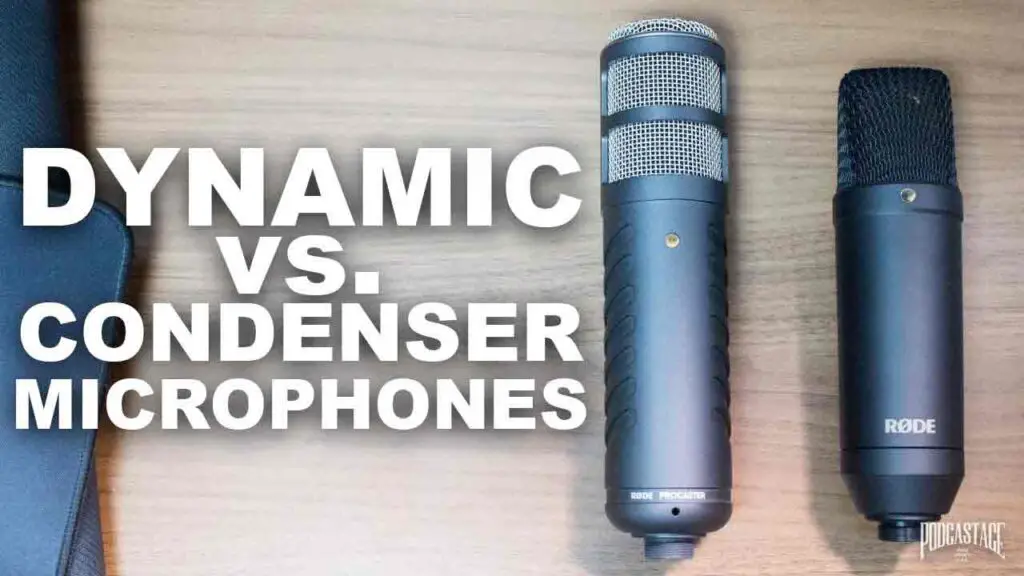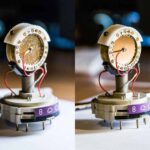Are Condenser Mics Better Than Dynamic?: Condenser microphones are often thought to be better than dynamic microphones, but this is not always the case. Condenser microphones are more sensitive and can capture a wider range of frequencies, making them ideal for recording studios.
However, dynamic microphones are more rugged and can handle high volumes without distortion, making them better for live performances.
Ultimately, the best microphone for any situation depends on the specific needs of the user.
No definitive answer exists to this question as it depends on the specific application for which you are using the microphone. That being said, there are some general guidelines that can be followed when deciding which type of microphone to use.
In general, condenser microphones are better suited for capturing high-frequency detail and transient response than dynamic microphones.
This makes them ideal for recording acoustic instruments and vocals. They are also typically more sensitive than dynamic microphones, meaning they require less gain from the preamp in order to produce a strong signal.
However, dynamic microphones are often preferred for live sound applications because they can handle high SPLs (sound pressure levels) without distortion and feedback is less likely to occur.
Additionally, they are usually less expensive than condenser microphones. So, which type of microphone is best? It really depends on your needs.
If you’re looking for a versatile mic that can be used for a variety of applications, a condenser mic is probably your best bet. But if you’re on a budget or need a mic specifically for live sound, a dynamic mic may be the way to go.
Also Read: Best Condenser Mic Under 200
Table of Contents
Dynamic Vs Condenser Mic Home Studio
When it comes to setting up a home studio, one of the most important decisions you’ll make is choosing the right microphones. Do you want dynamic or condenser mics? In this blog post, we’ll break down the differences between these two types of microphones so that you can make an informed decision for your home studio.
Dynamic microphones are well-suited for live performances because they’re able to handle high sound pressure levels. They’re also relatively inexpensive and rugged, making them a good option for recording in less than ideal conditions.
However, dynamic microphones tend to have a narrower frequency response than condenser microphones, meaning they may not capture all the nuances of your performance.
Condenser microphones are more sensitive than dynamic microphones and thus require phantom power to operate. They tend to be more expensive than dynamic microphones, but they offer a wider frequency response and greater detail in their sound reproduction.
Condenser microphones are typically used in studios because of their superior sound quality, but they can also be used for live performances if care is taken to avoid feedback problems.

Credit: www.youtube.com
Which Microphone is Better Dynamic Or Condenser?
There are two main types of microphones: dynamic and condenser. Each has its own strengths and weaknesses, so choosing the right microphone for your needs is important. Here’s a rundown of the differences between dynamic and condenser microphones to help you make the best decision for your needs.
Dynamic microphones are well-suited for live performances because they can handle high sound levels without distortion. They’re also relatively rugged and resistant to feedback, making them a good choice for onstage use.
However, dynamic microphones don’t have as wide a frequency response as condenser microphones, so they may not produce the same level of detail in recordings.
Condenser microphones are more sensitive than dynamic microphones, so they’re often used for Studio recording applications where capturing subtle nuances is important. They also have a wider frequency response than dynamic microphones, making them capable of reproducing sounds with greater fidelity.
However, condenser microphones require phantom power to operate and are more delicate than dynamic models, so they’re not ideal for live performances or other applications where durability is important.
What are the Advantages of a Condenser Microphone Over a Dynamic Microphone?
There are a few key advantages that a condenser microphone has over a dynamic microphone. For one, condenser microphones are generally much more sensitive than their dynamic counterparts. This means that they can pick up very subtle sounds and nuances in the audio signal that might be missed by a dynamic mic.
Additionally, condenser microphones typically have a wider frequency response than dynamic mics, meaning they can capture a greater range of sounds.
Finally, condenser microphones tend to produce a richer, fuller sound than dynamic mics due to their higher sensitivity and wider frequency response.
Do Streamers Use Dynamic Or Condenser Mics?
When it comes to choosing a microphone for streaming, there are two main types that streamers tend to use: dynamic and condenser microphones.
Each type has its own advantages and disadvantages, so it’s important to choose the right one for your needs. Dynamic microphones are great for streaming because they’re less sensitive to background noise.
This means that you won’t have to worry about your viewers hearing any unwanted sounds from your environment. They’re also relatively inexpensive, which is always a bonus. However, dynamic mics don’t usually produce as clear of a sound as condenser microphones.
Condenser microphones are typically more expensive than dynamic microphones, but they offer a clearer and more accurate sound. This makes them ideal for those who want their viewers to hear everything clearly.
However, because they’re more sensitive to background noise, you’ll need to make sure that your streaming environment is as quiet as possible if you want to use a condenser mic.
Why are Condenser Mics Better for Vocals?
Condenser microphones are well known for their clear and detailed sound. They are often used in studios for recording vocals and other instruments, as they tend to produce a very natural and lifelike sound. One of the main reasons why condenser mics are so popular is that they have a very wide frequency response.
This means that they can pick up all the nuances and subtleties in a vocal performance, which gives the recordings a much more realistic feel.
In addition to this, condenser mics also tend to have a very low noise floor, which makes them ideal for capturing delicate sounds like whispers or breaths.
Another reason why many engineers prefer condenser mics for Vocals is that they usually have a very smooth top end.
This means that sibilance (harsh “s” sounds) is less likely to be an issue when using one of these microphones. In contrast, dynamic microphones often have a slightly harsher top end, which can make sibilant sounds stand out more in recordings. Of course, there are also some disadvantages to using condenser microphones.
One of the biggest issues is that they require phantom power in order to work properly. This means that you need to use an external power source (usually 48v) in order to use most condenser mics – something that isn’t always possible in live situations.
Also You can check here best affordable condenser mics for vocals.
Additionally, because they are so sensitive, condenser mics can sometimes pick up unwanted background noise if they aren’t placed carefully within the recording space.
Condenser Mic Vs Dynamic Mic For Podcasting
When it comes to podcasting, choosing the right microphone can greatly affect the quality of your audio recordings. Two of the most popular types of microphones used in podcasting are condenser microphones and dynamic microphones. Here’s a comparison of the two, with a focus on their suitability for podcasting:
Sound Quality:
- Condenser Microphones: They generally have a wider frequency response and greater sensitivity compared to dynamic mics. This means they can pick up more detail and nuances in the voice, producing a more natural and clear sound. This can be advantageous for studio-quality podcasts.
- Dynamic Microphones: These mics are known for their robustness and ability to capture sound without much background noise. Their sound quality is generally considered to be a bit less detailed than that of condenser mics.
Durability & Use Case:
- Condenser Microphones: They are more sensitive and fragile. Best suited for controlled studio environments. They aren’t ideal for rough handling or traveling.
- Dynamic Microphones: Robust and durable, dynamic mics are often used for on-stage performances and field recordings. They can handle high sound pressure levels (SPL) without distortion.
Sensitivity to Ambient Noise:
- Condenser Microphones: Their sensitivity can be a double-edged sword. In quiet studio environments, they shine. But in noisier settings, they might pick up unwanted ambient sounds.
- Dynamic Microphones: Less sensitive to ambient noise, making them a good choice for podcasts recorded in less-than-ideal environments.
Powering Needs:
- Condenser Microphones: Require a power source, usually provided by phantom power from a mixer or audio interface.
- Dynamic Microphones: Do not require external power.
Price:
- Condenser Microphones: Can be more expensive, especially high-end models. There are, however, budget-friendly options available that deliver good quality for podcasting.
- Dynamic Microphones: Range from very affordable to professional-grade prices. Some podcast-favored dynamic mics are priced quite competitively.
Popular Choices for Podcasting:
- Condenser Microphones: Audio-Technica AT2020, Rode NT1-A, and Blue Yeti are among popular choices.
- Dynamic Microphones: Shure SM7B, Audio-Technica ATR2100x, and Heil PR-40 are often chosen for podcasting.
Your choice between a condenser and dynamic microphone for podcasting should depend on your specific needs and the environment in which you’ll be recording.
- If you’re in a quiet studio setting and desire a richer, detailed sound, a condenser mic might be the way to go.
- If you’re recording in a setting with some ambient noise or if you’re traveling frequently, a dynamic microphone might be more appropriate.
Lastly, always listen to samples and, if possible, test mics out in person before purchasing to find the best fit for your voice and podcasting style.
Dynamic Vs Condenser Mic Background Noise
When selecting a microphone for recording or live sound applications, understanding the characteristics of different microphone types can help you make the right choice for your specific needs. Two of the most common microphone types are dynamic and condenser microphones. Let’s discuss how they handle background noise.
- Dynamic Microphones:
- Construction: Dynamic microphones use a diaphragm/voice coil/magnet assembly that moves within the microphone, generating an electrical current.
- Background Noise Sensitivity: Generally speaking, dynamic microphones are less sensitive than condenser microphones. This means they are less likely to pick up ambient or background noise, especially at a distance. This characteristic makes them popular for live sound applications where background noise rejection is crucial.
- Usage: They are commonly used in live sound situations, like onstage for vocals or instrument miking, and for broadcast purposes.
- Noise Handling: Dynamic mics tend to have a more limited frequency response and are less detailed than condensers, which can be beneficial for rejecting unwanted noise.
- Condenser Microphones:
- Construction: Condenser microphones use a diaphragm placed very close to a backplate, forming a capacitor. When sound waves hit the diaphragm, the distance between the diaphragm and the backplate changes, resulting in a variance in electrical charge.
- Background Noise Sensitivity: Condenser mics are generally more sensitive and have a wider frequency response than dynamic mics. This means they can capture more detail, but this also makes them more prone to picking up ambient and background noises.
- Usage: Often found in studio settings (both for vocals and instruments), field recording, and on film sets.
- Noise Handling: Due to their sensitivity, condenser microphones, especially omnidirectional or wide cardioid ones, can pick up more room noise, equipment noise, or other unwanted sounds. However, directional condenser microphones, like supercardioid or hypercardioid, can provide a more focused area of sound pickup and reject more off-axis noise.
Other Factors to Consider:
- Polar Pattern: The polar pattern (or pickup pattern) of a microphone can significantly impact its susceptibility to background noise. For example, cardioid microphones pick up sound primarily from the front and reject sound from the sides and rear, making them less prone to background noise from the sides or back.
- Environment: The acoustics of your recording environment play a significant role. In a controlled studio environment, the increased sensitivity of a condenser microphone is often an advantage. In a noisy or live setting, a dynamic microphone’s robustness and noise rejection might be preferred.
- Purpose: If you’re recording delicate acoustic instruments or vocals in a studio, you might lean towards a condenser mic for its detail and accuracy. For louder instruments like electric guitar amps or live vocals in a noisy environment, a dynamic mic may be more appropriate.
While dynamic microphones are generally better at rejecting background noise due to their construction and less sensitive nature, the choice between dynamic and condenser should also consider the specific needs of the situation and the environment in which you’re working.
Condenser Vs Dynamic Mic For Zoom
When choosing between condenser and dynamic microphones for Zoom meetings, there are several factors to consider, including the type of environment in which you’ll be recording, your budget, and the desired sound quality. Here’s a breakdown of the two types of microphones and their suitability for Zoom:
Condenser Microphones:
- Sensitivity & Frequency Response: Generally have a wider frequency response and greater sensitivity than dynamic mics, which can lead to a more detailed and clearer sound. This can be particularly useful for capturing the nuances of a voice in a meeting or webinar.
- Powering: Require a power source, which usually comes from phantom power provided by mixers or audio interfaces. Some USB condenser mics can draw power directly from the computer.
- Best For: Controlled environments where there is limited background noise. They can pick up more ambient sound due to their sensitivity.
- Cost: Tend to be more expensive than dynamic mics, though there are affordable options available.
- Durability: More delicate than dynamic mics and may not tolerate rough handling or drops.
Dynamic Microphones:
- Sound Isolation: Generally better at rejecting ambient noise, which can be useful if you’re in a noisier environment.
- Powering: Do not require an external power source.
- Best For: Situations where you have a lot of background noise, or where durability is a concern.
- Cost: Often less expensive than condenser mics, making them a popular choice for budget-conscious users.
- Durability: Can handle rougher treatment and are less susceptible to moisture and other environmental factors.
Recommendation for Zoom:
If you’re in a relatively quiet environment and you’re looking for the best possible audio quality for your Zoom meetings, a condenser microphone might be the way to go. If you’re going with a USB microphone (which is generally easiest for Zoom and other conferencing software), there are many USB condenser options available.
If you’re in a noisier environment or are looking for something more robust and budget-friendly, a dynamic microphone could be a better choice. USB dynamic microphones are also available, though they’re less common than USB condenser mics.
Additional Tips:
Consider the acoustics of your room. If your room has a lot of echo or background noise, investing in some basic sound treatment (like foam panels) can be as important, if not more so, than the type of microphone you choose.
Using headphones instead of speakers can greatly improve sound quality by reducing feedback and echo during Zoom calls.
Regardless of the microphone type, placement is crucial. Make sure the microphone is placed close to your mouth, but not so close that it picks up unwanted pops or breathing noises. You might also consider purchasing a pop filter or windscreen.
In summary, both condenser and dynamic microphones can be effective for Zoom calls, but your specific needs and environment will dictate which is best for you.
Dynamic Vs Condenser For Gaming
When it comes to gaming, the microphone used isn’t often the most critical consideration. Still, for streamers or those involved in group play, a good microphone can significantly improve the experience for everyone involved. The two most common types of microphones you’ll hear about are dynamic and condenser microphones. Here’s a comparison of both for gaming:
Dynamic Microphones
Pros:
- Durability: Dynamic microphones are known for their robustness. They can handle accidental drops or rough use.
- No Need for Power: They don’t require phantom power to operate, which means you can plug them directly into most devices without the need for additional equipment.
- Better at Rejecting Ambient Noise: They’re often better at isolating the speaker’s voice, which is particularly useful in noisy environments.
Cons:
- Sound Quality: While they can produce good quality sound, they might not be as detailed or as clear as condenser microphones.
- Bulkier: Some dynamic mics, especially broadcast-quality ones, can be large.
Condenser Microphones
Pros:
- Sound Quality: Condenser microphones generally offer better sound clarity and more detailed audio capture compared to dynamic microphones.
- Versatility: They are versatile and can be used for multiple purposes beyond gaming, such as recording vocals or instruments.
- Compact Options Available: There are many compact and USB-powered condenser microphones available, making them easy to use with a computer setup.
Cons:
- Requires Power: They need a power source, typically phantom power. However, many USB condenser mics designed for computers will draw power directly from the USB port.
- Sensitive: They can pick up background noises more easily, which might not be ideal if you’re in a noisy environment.
- Fragility: They are more fragile compared to dynamic mics and may not handle drops or impacts as well.
For Gaming:
- Casual Gaming: If you’re a casual gamer, either type will work. A USB condenser microphone is probably the easiest plug-and-play solution.
- Streaming: If you’re streaming, sound quality becomes more important. In this case, a condenser microphone might be the better choice due to its clarity. However, if you’re in a noisy environment, a dynamic microphone might help isolate your voice from the noise.
- Professional Commentary/Broadcasting: If you’re getting into professional commentary or broadcasting, you might want to invest in a high-quality dynamic microphone, as many professionals in radio and broadcasting prefer them.
Ultimately, the choice between a dynamic and condenser microphone for gaming boils down to your specific needs, preferences, and the environment in which you’re gaming.
Dynamic vs Condenser Microphones | What’s The Difference?
FAQ
1. What’s the primary difference between a condenser mic and a dynamic mic?
A condenser microphone uses a capacitor (or condenser) to convert acoustical energy into electrical energy. It requires power (from batteries or phantom power) to maintain an electrical charge between its internal plates. Dynamic microphones, on the other hand, use a diaphragm attached to a coil of wire, placed within the magnetic field of a magnet, to generate an electrical signal.
2. Are condenser mics more sensitive than dynamic mics?
Yes, condenser microphones are generally more sensitive and provide a wider frequency response and greater transient response than dynamic microphones.
3. Are condenser mics better for studio recording?
Many studio recordings, especially vocals and acoustic instruments, utilize condenser microphones due to their sensitivity, wide frequency response, and ability to capture fine details and nuances.
4. Where are dynamic mics typically used?
Dynamic microphones are often preferred for live sound applications and for miking loud sound sources like guitar amplifiers and drums because of their durability, feedback rejection, and ability to handle high sound pressure levels (SPL).
5. Do I need any external power for a dynamic mic?
No, dynamic microphones generate an electrical signal without the need for external power. However, condenser microphones do require power, usually supplied by a battery or phantom power from a mixer or audio interface.
6. Are condenser mics more fragile than dynamic mics?
Generally, yes. Condenser mics are more sensitive and can be more prone to damage from rough handling, moisture, and extreme temperatures. Dynamic mics tend to be more rugged and durable.
7. Which type of mic is better for podcasting or broadcasting?
Both can be used. Condenser mics are often chosen for studio podcasting because of their clarity and detail, but dynamic mics can be preferred for broadcasting or podcasting in unpredictable environments due to their durability and rejection of ambient noise.
8. Is one more expensive than the other?
Condenser microphones can be more expensive than dynamic ones, especially when looking at high-end models. However, there are budget options available for both types.
9. Which one is better for home studios?
It depends on the application. For vocals, voiceovers, and acoustic instruments, a condenser mic may be preferred. For louder sources or if you’re in a noisy environment, a dynamic mic might be more appropriate. Many home studios have both types to cover a range of recording needs.
10. Are there hybrid microphones that combine both technologies?
There are some microphones that attempt to blend the characteristics of both types, but they are less common. Usually, a specific microphone technology is chosen for its distinct advantages in a given situation.
Neither condenser nor dynamic microphones are “better” universally. Each has its advantages and best-use scenarios. Your choice should be based on your specific needs, environment, and budget.
Conclusion
Dynamic microphones are typically less expensive than condenser microphones, and they’re often used in live performances because they’re less likely to pick up background noise.
However, condenser microphones are generally considered to be better quality than dynamic microphones, and they’re often used in studio recordings.

Williams Kane is a blogger and writer. He’s passionate about writing and connecting with the community, especially when it comes to sharing his ideas through writing.
I am a versatile author with a passion for exploring a wide range of topics on our multi-niche website. With a background in research and a love for writing, I bring a unique blend of expertise to our platform.
My journey began in the world of science, where I earned a degree in biology and developed a deep fascination for the natural world. This background enables me to delve into topics related to ecology, environmental conservation, and the wonders of the animal kingdom.
However, my curiosity knows no bounds, and I have ventured into various other niches as well. From technology trends and digital innovations to health and wellness tips, I strive to provide well-researched and engaging content that informs and entertains our diverse audience.
Furthermore, my dedication to staying current with the latest developments in each niche ensures that our readers receive up-to-date and reliable information. Whether it’s deciphering complex scientific concepts or simplifying tech jargon, I take pride in making complex subjects accessible to all.
Join me on our multi-niche journey, where we explore the depths of knowledge and share insights on a multitude of topics to inspire, educate, and entertain.



